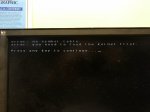Mirroring is wasteful for a home user,
Any redundancy is wasteful until you need it, then it isn't any more. Mirrors are the simplest and cheapest way to get redundancy with a small install. Of course you can use RAID5/6 (or RAIDZ1/2) with potentially a smaller penalty for redundancy, but then you have other problems: with btrfs it's unstable and poorly designed (
e.g., parity isn't checksummed, they developed it with a write hole); with ZFS it's stable, but you're locked into that number of devices in the vdev.
Disks are cheap, and if we're talking about a home user with presumably-small storage requirements, they're very cheap indeed. A 4 TB WD Red disk is US$137 today. A pair of them is US$274, which will give 4 TB of redundant storage. A 2 TB WD Red is US$85 today, so three are US$255 to get 4 TB in RAID5/RAIDZ1. The penalty for mirrors is $19. Balance that against ease of expansion and greater flexibility, and I think it's well worth it.
With larger storage demands, mirrors don't make much sense unless there are other reasons (like high IOPS). But if we're talking home users, the "waste", if any, is minimal.
Have you read the original blog post where one of the developers talks about it?
Yes, but I'm now thinking I misread your earlier post. I read "the only people who can implement it just don't care about it anymore" with the "it" referring to a ZFS server--that is, the only people who can deal with its requirements are those who just don't care about the cost. I don't believe that's the case, as I don't think the cost needs to be very high. But now it sounds like the "it" refers to block pointer rewrite, which would be necessary to expand/shrink vdevs and/or change RAID levels--and in that case, I'm inclined to agree that it isn't likely to happen. I don't think it's the case that the devs don't care, necessarily, so much as that it would be too much work, if possible at all, to add it now. Though I understand they are working on the ability to remove vdevs from a pool, which would be a good step (especially for those people who insist on ignoring all the warnings and adding a single disk to their RAIDZ pools).
Of course, none of this has anything to do with your boot issues--those, I expect, are something to do with FreeBSD and your hardware, and have nothing to do with any filesystem.

